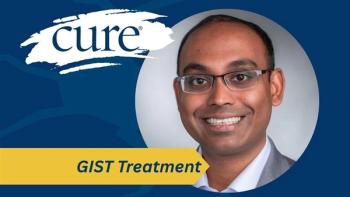
Consider Endocrine Therapy Responses When Planning Chemo in Breast Cancer Subset
Results from the ADAPTcycle trial found that endocrine therapy plus ovarian suppression can generate high response rates in patients with HR-positive, early breast cancer, regardless of age.
The decision for patients to receive chemotherapy should depend on their response to endocrine therapy and gene expression testing, for patients with hormone receptor-positive, HER2-negative, non-invasive, early breast cancer, according to findings from the multicenter ADAPTcylcle trial, which were presented at the
“Endocrine therapy response should be considered in addition to gene expression testing for routine decision-making regarding chemotherapy use in hormone receptor-positive, HER2-negative, (non-invasive), early breast cancer, to maximize the number of patients in whom chemotherapy can be spared,” Dr. Oleg Gluz, of the West German Study Group, said in a presentation in the findings.
Researchers screened 5,293 German women with intermediate- to high-risk hormone receptor-positive, HER2-negative, early breast cancer. Among this sample, there were 4,334 women with all the available characteristics to be evaluated for this study.
Ultimately, 1,684 patients were randomly assigned to receive either (neo)adjuvant endocrine therapy plus two years of Kisqali (ribociclib) or (neo)adjuvant chemotherapy with standard endocrine therapy as part of the ADAPTcycle trial. However, the findings presented at the 2023 Symposium are focused on the larger pool of 4,334 women who had been screened.
Of note, this sample included 1,423 patients endocrine therapy responders (63%), of which 659 (48.2%) were 50 years or younger, and 2,155 (72.7%) were older than 50 years.
An endocrine response was defined as Ki67 (a protein biomarker) below or equal to 10% after two to four weeks of preoperative endocrine treatment. Patients were assessed in subgroups according to endocrine therapy received, their age, and their recurrence score.
The median overall endocrine therapy response was 9.9 (min/max). In the younger population, the median response, specifically, was 9.2 (min/max) and in the older population, it was 10.3 (min/max).
The data showed that adding ovarian function suppression (OFS) to tamoxifen or aromatase inhibitors significantly increased the likelihood of response in premenopausal patients. The rates of responses were similar to those seen with postmenopausal patients previously treated with an aromatase inhibitor.
The findings suggested that when treated with optimal endocrine therapy, both pre- and postmenopausal patients have similar levels of endocrine therapy sensitivity, according to Gluz.
Key Findings
The researchers determined the likelihood of response to endocrine therapy in a group of 4,334 patients with hormone receptor-positive, HER2-negative, non-invasive, early breast cancer, by analyzing the screening cohort from the WSG ADAPTcycle trial.
“If you looked on the multivariable analysis for endocrine response as an endpoint, we have observed that treatment, age, recurrence score, and baseline Ki67 and estrogen receptor expression by immunohistochemistry…. all these factors were independently associated with endocrine responses in this cohort and provide further information,” Gluz said.
Endocrine Responders
In the population of patients whose Ki67 scores were less than 10% at baseline, the rate of response in the 50 years or younger population was 34.7% (277 patients) with tamoxifen alone, 55.7% (142 patients) with tamoxifen and OFS, and 76.4% (240 patients) with an aromatase inhibitor plus OFS.
Among the 50 years or older cohort, the response rate was 43.8% (159 patients) with tamoxifen, 76.4% with aromatase inhibitors (1,892 patients) and 82.5% (104 patients) with endocrine therapy plus OFS.
In the ADAPT trial, the response rate with tamoxifen was 40.1% in the premenopausal population of endocrine responders, and the rate of responses with an aromatase inhibitor alone in the postmenopausal population was 81.5%. These findings from the larger population, therefore, confirmed the likelihood of these response rates.
Furthermore, as Gluz pointed out, adding the OFS increased the response rates in both populations.
“If ovarian suppression was added to (the) younger patient’s (treatment) in that short period of time before the surgery, the endocrine response rates brought was up to 77% in patients treated by aromatase inhibitors in this younger group,” he said, “(Response) levels which were (also) observed in older patients.”
Patients With High Recurrence Score
Among patients who were 50 years or younger and whose recurrence scores were between 0 and 25, the response rates were 44.0% (201 patients) with tamoxifen alone, 68.1% (81 patients) with tamoxifen and OFS and 81.8% (126 patients) with an aromatase inhibitor plus OFS.
Among patients who were 50 years or younger and whose recurrence scores were between 26 and 100, the response rates were 15.8% (35 patients) with tamoxifen alone, 40.8% (29 patients) with tamoxifen and OFS and 66.7% (54 patients) with an aromatase inhibitor plus OFS.
Among patients who were older than 50 years and whose recurrence scores were 0 and 25, the response rates were 57.1% (141 patients) with tamoxifen alone and 87.9% (1,247 patients) with an aromatase inhibitor alone.
Among patients who were older than 50 years and whose recurrence scores were between 26 and 100, the response rates were 18.2% (14 patients) with tamoxifen alone and 55.6% (399 patients) with an aromatase inhibitor alone.
“As expected, patients with higher recurrence score levels had less endocrine response rates,” Gluz said. “But, if adequate endocrine treatment was (added), in the younger patients, we observed up to 67% endocrine responder (rates) in cases with higher recurrence scores and 55% of patients with (high) recurrent scores (achieved) endocrine response in our postmenopausal patients.”
The Premenopausal Population
Among patients who were 40 years or younger and whose recurrence scores were between 0 and 25, the response rates were 49.4% (41 patients) with tamoxifen alone, 70.6% (24 patients) with tamoxifen and OFS, and 93.5% (29 patients) with an aromatase inhibitor plus OFS.
Among patients who were younger than 40 years and whose recurrence scores were between 26 and 100, the response rates were 11.9% (seven patients) with tamoxifen alone, 39.3% (one patient) with tamoxifen and OFS, and 69.0% (20 patients) with an aromatase inhibitor plus OFS.
“In this population, we observed very substantial endocrine response rates — up to 94% in patients with recurrence scores up to 25 if OFS was done (in addition to aromatase inhibitors), and up to 70%, endocrine response rates in cases of recurrence scores over 25,” Gluz emphasized.
Findings in Context
Previously, findings from the WSG ADAPT HR-positive/HER2-negative trial showcased “excellent” five-year patient outcomes. Specifically, the five-year distant disease-free survival (dDFS) rate associated with adjuvant endocrine therapy alone was 97% among a population of patients who were 50 years or younger, had N0-1 hormone receptor-positive/HER2-negative early breast cancer, had a recurrence score equal to or less than 25, and who had achieved a response to endocrine therapy after short preoperative endocrine therapy.
Since then, emerging data from other prospective trials have suggested that adjuvant chemotherapy plus endocrine therapy may be more effective in younger populations versus endocrine therapy alone, but not in postmenopausal patients. Investigators have theorized why this is — positing that distinct tumor biology in pre- vs postmenopausal patients, chemotherapy-induced amenorrhea, or the use of tamoxifen alone without ovarian suppression could be responsible. Yet the answer remains unknown.
These findings seek to better define the benefit of endocrine therapy and the likelihood of responses according to age and other stratification factors. Findings were based on the screening cohort of the WSG ADAPTcycle trial.
Follow-up from the ADAPTcycle will determine the impact of endocrine therapy response, with and without ovarian function suppression, on survival outcomes.
For more news on cancer updates, research and education, don’t forget to





